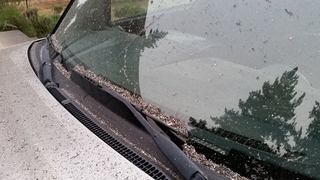
Wildfire Ash
Please follow the tips below to safely dispose of ash resulting from local wildfires. And remember, please do not attempt to clean up ash while it's still circulating in the air. Your safety is the top priority.
NEW: Download a copy of the County's Thomas Fire Preliminary Ash Management Plan.
To clean ash resulting from wildfires, please remember the three C's: Control, Contain and Capture:
Control: Try to control the amount of ash particles that get re-suspended into the air. Avoid using any equipment that blows ash into the air, such as shop vacuums or leaf blowers. Instead, use vacuums with HEPA filters.
Contain: Contain ash by gently sweeping indoor and outdoor hard surfaces followed by wet mopping with a damp cloth. Ash may be disposed of in plastic bags in regular trash receptacles. You may also allow water from cleaning to drain into landscaping, as ash will not hurt plants or grass.
Capture: Protect storm drains from ash and any cleaning chemicals used while cleaning by diverting away from storm drains or recapturing. Ash is highly acidic, which is harmful for people, the environment, and aquatic life.
Here are some more recommendations for safe clean-up (also available as a PDF in English and Spanish):
- DO NOT USE LEAF BLOWERS under any circumstances as they blow the fine particles around and create more health concerns. Alternatives to leaf blowers include:
- Sweep gently with a push broom and then hose lightly with water. Take care to conserve water. Ash can be put in plastic bags and then placed in trash receptacles.
- Using a shop vacuum equipped with a high-efficiency particulate filter (HEPA) and a disposable filter bag.
- Avoid skin contact with ash. Although ash from organic materials like trees and brush is not harmful to the skin, ash from burned homes and other items will likely contain metals, chemicals, and potentially asbestos, items that may be considered toxic if breathed in or touched with wet skin. If you are cleaning ash from a burned home or car, take special care to protect your health. If you do get the ash on your skin, wash it off immediately. Some wet ash from burned homes or cars can cause chemical burns.
- Inhaled ash may be irritating to the nose, throat, and lungs. Use protective wear. Wear a tight fitting N95 respirator mask or P-100 mask, gloves, long-sleeved shirts, and long pants when cleaning up ash. No one with heart or lung conditions should handle ash clean-up.
- Avoid getting ash into the air as much as possible. If sweeping up ash, sweep gently. Use water and a wet cloth or mop to clean items and surfaces.
- Avoid doing activities that stir up ash. Do not allow children to play in ash or be in an area where ash-covered materials are being disturbed. Wash ash off toys before children play with them.
- Clean ash off pets.
- Do not consume any food, beverages, or medications that have been exposed to smoke, ash, heat, pressure, or chemicals.
- Commercial cleaning may be needed for carpet, upholstery, and window treatments. Clean and sanitize utensils, glasses, dishware and food contact areas, such as countertops and cupboards. To decontaminate these items:
- Wash them in a strong detergent solution.
- Soak in a bleach solution of one teaspoon of bleach per quart of water. Soak for 15 minutes.
- Wash, rinse, and then air dry.
Additional Resources for Clean-Up:
General Assistance
Health
- Santa Barbara County Department of Public Health (clinic services, hours, etc.)
If you have symptoms that may be related to exposure to smoke or soot, consult your doctor. Symptoms include repeated coughing, shortness of breath, or difficulty breathing, wheezing, chest tightness or pain, palpitations, headaches and nausea or unusual fatigue or lightheadedness.
Related Articles
-
“Less Is More” Guide Hot Off the Press
January 18, 2023 by Kaitlyn Haberlin - Recycle, Reduce & Reuse -
Thomas Fire Clean-Up Tips & Guidelines
-
Ash Clean-up Guidelines
December 15, 2017 by Leslie Robinson - Trash -
Normal Trash Collection Schedule Resumes December 14
-
Facility Closures and Trash Service Delays Due to Thomas Fire